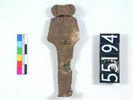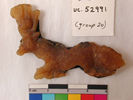| Homepage | Timeline | Maps | A-Z index | Learning |
Amulets: wax
All ancient Egyptian wax is beeswax, either pure or with resin, oil or other pigments. There was evidently a strong belief that, as a malleable material easily burned, wax is powerful, especially for inflicting change or harm on a creature. Many of the most colourful written references come from Ptolemaic and Roman Period sources, when influences from abroad may have taken hold. Papyrus Salt 825 (BM 10051) contains directions for modelling wax figures of enemies in order to destroy the name of Seth. A tale about Alexander the Great, written by the 'pseudo-Callisthenes', describes that Nectanebo II was a great magician: the king used wax figures in secret rooms of his palace, to defeat the armies of his enemies. In a Greek magical papyrus (Leiden inv. AMS. 75, cat. I 384 - 4th century AD) is described the making of a group of wax and herb figures of Eros and Psyche, to gain power over all men and women. In earlier periods, though, there are also many references to the modelling of wax figures, in instructions for reciting incantations, and in the judicial records on a conspiracy against king Ramesses III.
No wax figures certainly associated with incantations have survived. The earliest wax figures found date to the First Intermediate Period (about 2100 BC), and come from a funerary context. These are small human figures, perhaps representing the dead. Especially many wax figures are know from the Late, Ptolemaic and Roman figures; some may be from metal-casting procedures rather than religious in function. However, the most common images from these periods are amulets in the form of the four children of Horus, placed on mummies. In the Ptolemaic and Roman Periods Egyptian amulets are often made in wax, sometimes gilt.
|
wax amulets: unprovenanced
|
Ramesseum
|
wax amulets found at Denderah
|
|


